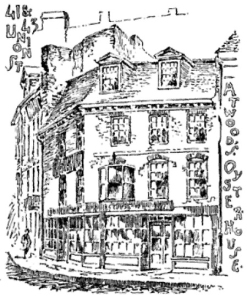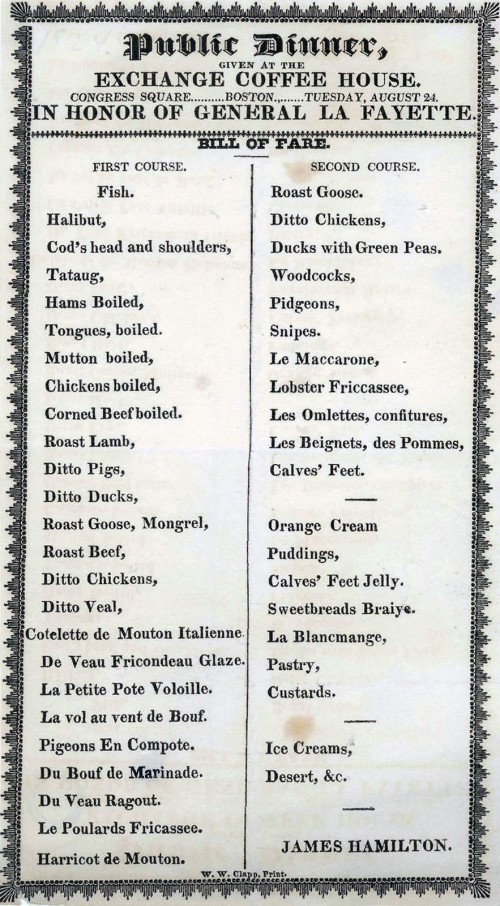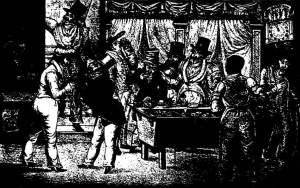 Aside from roadside inns, most eating places are found in cities in this decade. With a population slightly over 150,000 New York is more than twice as big as its nearest rivals, Philadelphia and Baltimore, but most cities are considerably smaller. In 1820 only 12 have populations over 10,000, all of them along the East Coast with the exceptions of Albany NY and New Orleans LA.
Aside from roadside inns, most eating places are found in cities in this decade. With a population slightly over 150,000 New York is more than twice as big as its nearest rivals, Philadelphia and Baltimore, but most cities are considerably smaller. In 1820 only 12 have populations over 10,000, all of them along the East Coast with the exceptions of Albany NY and New Orleans LA.
Yet industrial development is underway. After a financial panic at the decade’s beginning, textile mills in Massachusetts begin large-scale production. The Erie Canal goes into operation with its completion in 1825, spurring commercial development in NYC. With the city’s expansion there is greater distance between work in lower Manhattan and places of residence, bringing more customers to oyster cellars and taverns. But New York still lags behind Boston in its supply of refined French restaurants.
Big hotels begin to be established, most notably Baltimore’s City Hotel (1826), Philadelphia’s United States Hotel (1827), Washington’s National Hotel (1827), and Boston’s Tremont Hotel (1829). In most hotel dining rooms it is still the custom to put all the food – soup, meat, vegetables, puddings — on the table at once. Except for the occasional banquet, menus are not printed. A list of available dishes is chanted by waiters or chalked on a board behind the bar.
Apart from eating in hotels while traveling, “respectable” women stay home. They avoid public dining spots, especially oyster houses or cellars which are associated with heavy drinking and the burgeoning male “sporting life” of gambling and frequenting prostitutes.
The temperance movement begins. Since there is little separation between eating and drinking places, restaurants are targeted as sites of temptation and moral downfall. Religious publications warn readers that it’s a slippery slope from sipping “innocent soda water” in a pleasure garden to getting drunk in the oyster house or “the common grog shop.”
Highlights
1820 Aiming for well-off gentlemen, Dudley Bradstreet advertises fine venison, “a warm room and the best of wine” at his Phoenix Restorator in Boston.
1821 In summer wealthy New Yorkers vacation in Saratoga Springs and environs where they enjoy Wild Pigeons, Pike, and Bass “taken daily at the foot of the much celebrated Cohoes Falls” at S. Demarest’s Mansion House.
1823 A visiting Frenchman complains he cannot get French cooking in New York’s typical English-style chop houses. He pleads, “Will any body be kind enough to point out a veritable French coffee house or restaurateur in New-York, where ‘haricot mutton,’ ‘coutulettes a la maintenon,’ and sundry other dishes may be procured?”
 1824 France’s marquis de Lafayette, friend of the American revolution, pays a return visit to the US and is feted with a dinner at Boston’s Exchange Coffee House which features an astonishing selection of American and French dishes.
1824 France’s marquis de Lafayette, friend of the American revolution, pays a return visit to the US and is feted with a dinner at Boston’s Exchange Coffee House which features an astonishing selection of American and French dishes.
1826 A teenager named Hawes Atwood opens an oyster saloon on Boston’s Union Lane which he will operate into the 1890s. (Still in business and now known as Ye Olde Union Oyster House, it is the nation’s oldest restaurant in continuous operation, looking very much the same as in its 1889 illustration above.)
1826 To the delight of a passerby who copies it in his notebook exactly as it appears, a sign at a Philadelphia oyster cellar captures the speed and energy of the spoken bill of fare: “OystersOPENED,ORINSHELLFriedorstuedBEER,PORtE,ALE”
1827 Swiss immigrants Giovanni and Pietro Del Monico arrive in New York and establish a small European-style confectioner’s shop serving pastries, coffee, wine, and liquor at 23 Williams Street.
1828 Black caterer Edward Haines opens a summertime Mead Garden on the corner of Front and Jay streets in Brooklyn NY.
1828 The editor of the Trumpet & Universalist Magazine applauds a Providence RI restaurant keeper who has “substituted at his Restorateur hot coffee in lieu of intoxicating alcohol.” “If a man must drink at 11 o’clock, he writes, “let him drink Hot Coffee.” (By the way, he is referring to 11 A.M.)
 1829 Downtown in NYC patrons of the dark and dreary, but cheap, Plate House crowd into box-like seating and wolf down plates of beef and potatoes. Child waiters shout orders to the kitchen followed by the guests’ box numbers (Half plate beef, 4!). [Philadelphia oyster cellar pictured; note curtained booths]
1829 Downtown in NYC patrons of the dark and dreary, but cheap, Plate House crowd into box-like seating and wolf down plates of beef and potatoes. Child waiters shout orders to the kitchen followed by the guests’ box numbers (Half plate beef, 4!). [Philadelphia oyster cellar pictured; note curtained booths]
© Jan Whitaker, 2012
Read about other decades: 1810 to 1820; 1860 to 1870; 1890 to 1900; 1900 to 1910; 1920 to 1930; 1930 to 1940; 1940 to 1950; 1950 to 1960; 1960 to 1970; 1970 to 1980

 The Downing family of caterers and restaurateurs, Thomas and his sons George T. and Peter W., were activists in the causes of the abolition of slavery, black suffrage, and black education. They assisted Afro-Americans fleeing slavery before Emancipation as well as those escaping terrorism in the South in the post-Civil War period. Like many free blacks living in cities, they took up the catering trade. Similar to undertaking and barbering, catering was a personal service occupation which offered a degree of opportunity for enterprising people of color.
The Downing family of caterers and restaurateurs, Thomas and his sons George T. and Peter W., were activists in the causes of the abolition of slavery, black suffrage, and black education. They assisted Afro-Americans fleeing slavery before Emancipation as well as those escaping terrorism in the South in the post-Civil War period. Like many free blacks living in cities, they took up the catering trade. Similar to undertaking and barbering, catering was a personal service occupation which offered a degree of opportunity for enterprising people of color. Thomas Downing (pictured), the son of freed slaves from Virginia, specialized in oysters. He opened an oyster cellar on Broad Street in New York City in the 1820s, gradually expanding it and earning a fine reputation. Often oyster cellars were “dives” but his was considered first class. He won awards for his pickled oysters which, along with his boned and jellied turkeys, were especially popular at Christmas (see 1856 ad). Over time he owned the Broad Street place and at least one other in NYC and, according to a Rhode Island directory, another in Providence. However, the press seemed always to confuse the various Downings, so it’s possible the latter was under the direction of a son.
Thomas Downing (pictured), the son of freed slaves from Virginia, specialized in oysters. He opened an oyster cellar on Broad Street in New York City in the 1820s, gradually expanding it and earning a fine reputation. Often oyster cellars were “dives” but his was considered first class. He won awards for his pickled oysters which, along with his boned and jellied turkeys, were especially popular at Christmas (see 1856 ad). Over time he owned the Broad Street place and at least one other in NYC and, according to a Rhode Island directory, another in Providence. However, the press seemed always to confuse the various Downings, so it’s possible the latter was under the direction of a son. Thomas’s place on Broad was patronized by men in political and financial circles and he was rumored to have influential connections. Both his sons, George and Peter, had enough pull to win concessions for restaurants in government buildings. Peter ran an eating place in the Customs House in NYC, while George, a friend of MA Senator Charles Sumner, managed one in the House of Representatives in Washington, D.C. George (pictured) was also well known as the proprietor of a resort hotel, the Sea Girt House, in Newport, Rhode Island.
Thomas’s place on Broad was patronized by men in political and financial circles and he was rumored to have influential connections. Both his sons, George and Peter, had enough pull to win concessions for restaurants in government buildings. Peter ran an eating place in the Customs House in NYC, while George, a friend of MA Senator Charles Sumner, managed one in the House of Representatives in Washington, D.C. George (pictured) was also well known as the proprietor of a resort hotel, the Sea Girt House, in Newport, Rhode Island.










 It's great to hear from readers and I take time to answer queries. I can't always find what you are looking for, but I do appreciate getting thank yous no matter what the outcome.
It's great to hear from readers and I take time to answer queries. I can't always find what you are looking for, but I do appreciate getting thank yous no matter what the outcome.


